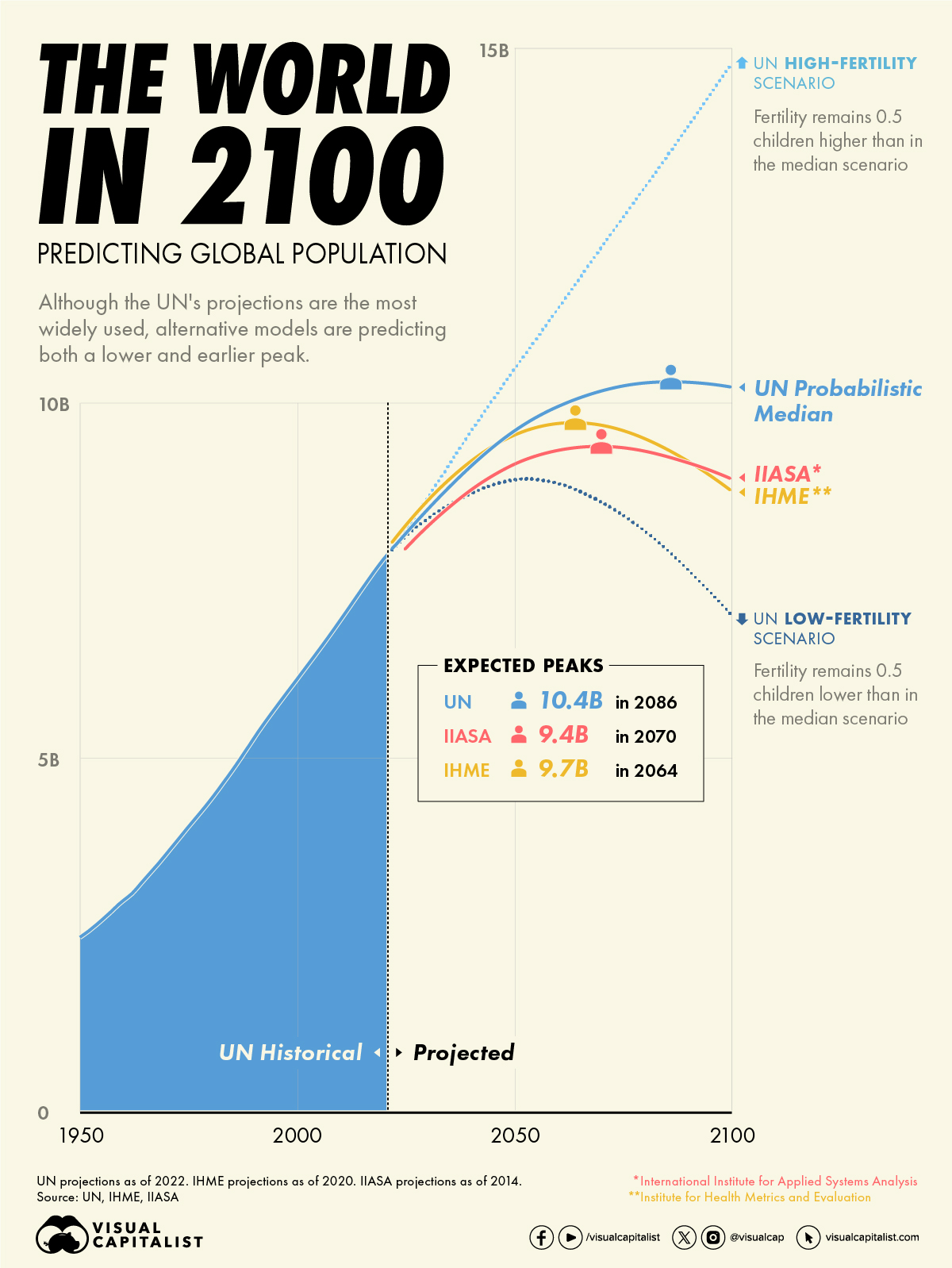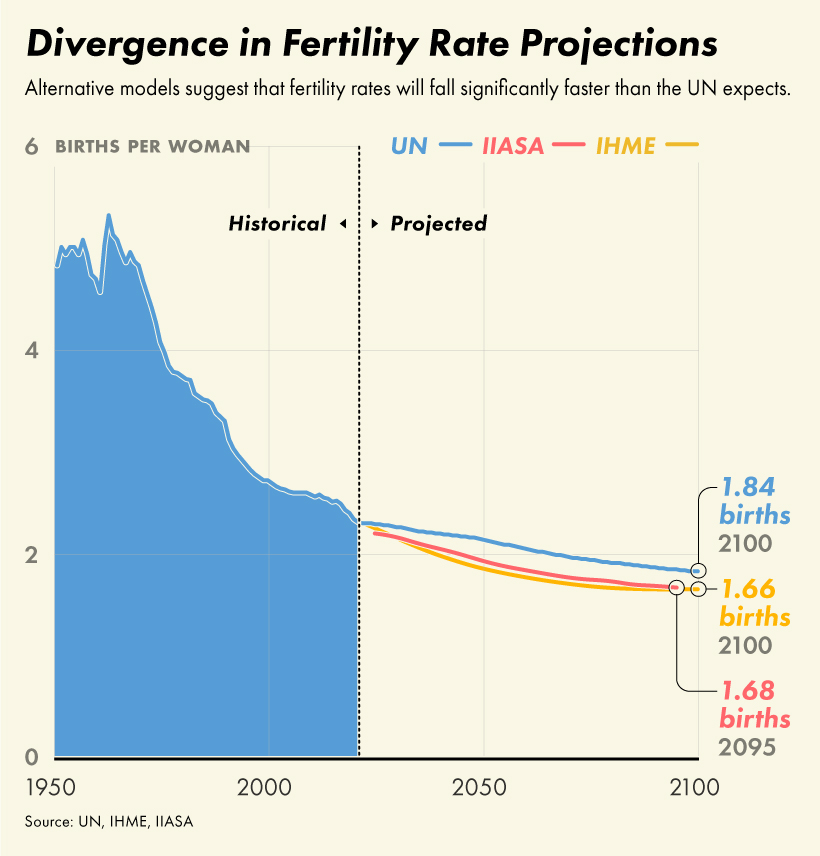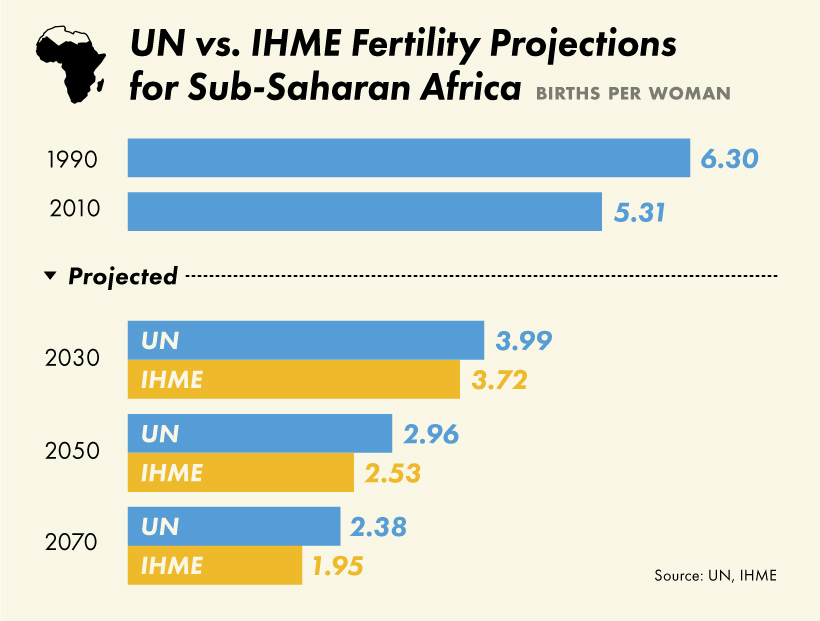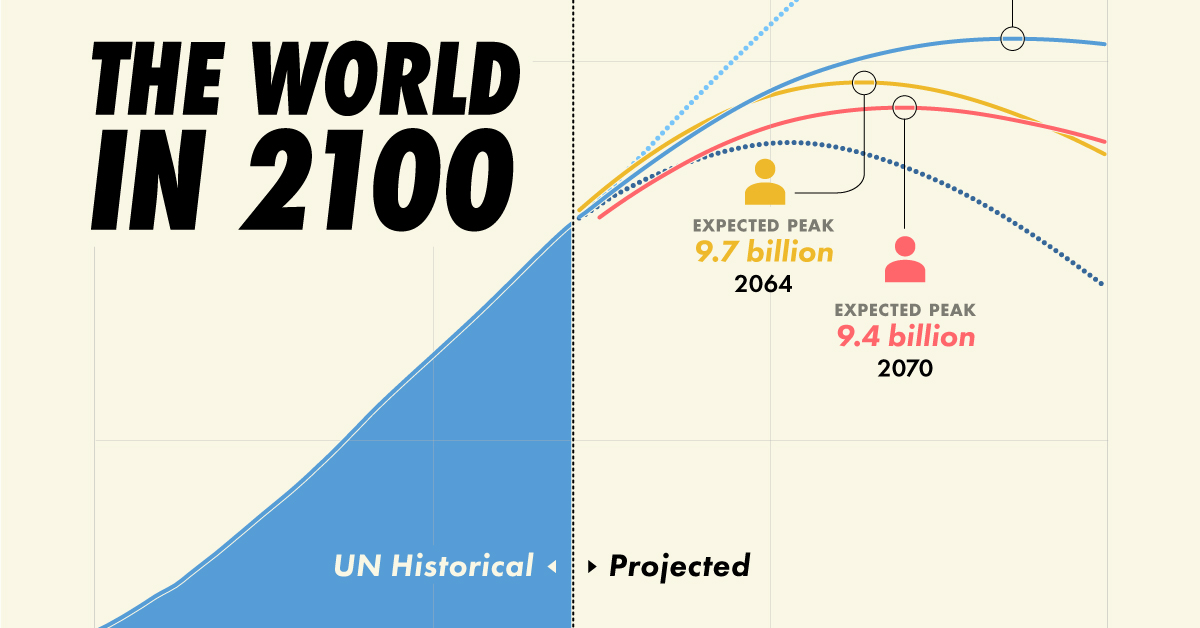Demographics
When Will the Global Population Reach Its Peak?

Comparing Global Population Projections to 2100
When will the world reach its peak population?
According to data from the United Nations’ 2022 Revision of its World Population Prospects, we could see a peak of over 10.4 billion people sometime in the late 2080s.
While the UN’s projections are the most widely used, this doesn’t necessarily mean they’re the most accurate. Several alternative models have predicted an earlier and lower peak, suggesting that the world’s population could decline sooner than expected.
In the UN’s latest revisions, it lowered its own estimates for global population in 2100, from 10.9 billion (as of 2019) to 10.4 billion (as of 2022).
In this graphic, we’ve visualized population projections to 2100 from three organizations: the UN, the Institute for Health Metrics and Evaluation (IHME), and the International Institute for Applied Systems Analysis (IIASA).
Data and Highlights
The population projection data we used to create this graphic is listed in the table below. Note that UN projections are as of 2022, IHME are as of 2020, and IIASA are as of 2014.
| Year | UN | IHME | IIASA |
|---|---|---|---|
| 2050 | 9,687,440,000 | 9,551,506,077 | 9,140,396,000 |
| 2060 | 10,053,522,000 | 9,719,318,272 | 9,340,845,000 |
| 2070 | 10,288,412,000 | 9,700,610,324 | 9,397,164,000 |
| 2080 | 10,411,747,000 | 9,515,888,869 | 9,334,601,000 |
| 2090 | 10,425,269,000 | 9,200,632,391 | 9,173,133,000 |
| 2100 | 10,355,002,000 | 8,785,553,665 | 8,948,235,000 |
From this data we can see that the UN expects the world to hit peak population in 2086, as well as maintain above 10 billion people in 2100.
On the other hand, neither the IHME nor IIASA models expect global population to reach 10 billion, instead forecasting a peak of 9.7 billion in the 2060s (IHME) or 9.4 billion in 2070 (IIASA). Both models also predict population to fall back to the 8 billion range by 2100.
The differential at 2100 is substantial, with IHME’s forecast lower than the UN’s by 1.6 billion people, for example.
What Is the IHME and IIASA, and Why Do They Differ?
The Institute for Health Metrics and Evaluation (IHME) is a Seattle-based research institute founded in 2007 by the Bill & Melinda Gates Foundation. Its mission is to “deliver to the world timely, relevant, and scientifically valid evidence to improve health policy and practice.”
The International Institute for Applied Systems Analysis (IIASA), on the other hand, is an international research institute based in Austria, dating back to 1972. It was established to improve scientific cooperation between the Soviet Union and the U.S., and today has members in over 20 countries.
To understand why the IHME and IIASA models differ from the UN’s, let’s look at each organization’s projections for fertility rate, which is measured as the number of children per woman.

Based on this chart, the IHME and IIASA expect global fertility rates to fall at a quicker rate pre-2050, then stabilize as we approach 2100. This contrasts with the UN’s projections, which expect fertility to decrease at a slower, steadier rate all the way to 2100.
Generally speaking, a country’s birth rate declines as it becomes more developed. This is due to many factors like higher education rates for women (and thus more women in the workforce), greater access to contraceptives and family planning, as well as higher childbearing costs.
How Fast Will Fertility Rates Fall in Africa?
Sub-Saharan Africa has one of the highest fertility rates in the world, but this is quickly falling as the region experiences rapid economic growth.. For instance, GDP per capita in Sub-Saharan Africa has climbed from $632 in 2000, to $1,690 in 2022.
Because of this economic transformation, some researchers believe that Africa will undergo a fast demographic transition similar to East Asia, in which population growth falls off sharply. For instance, a UNICEF survey from 2021 found that fertility rates in Nigeria had fallen from 5.8 to 4.6 (a 17% decrease) in just five years time.
Now going back to the question at hand, let’s see how the UN and IHME’s fertility rate projections for Sub-Saharan Africa differ.

These differences may seem small, but even a few decimal places can have a huge impact. For example, let’s revisit the UN’s population projection for the year 2100, which was 10.4 billion people.
Under the UN’s low fertility scenario (birth rates remain 0.5 lower), population in 2100 would be a significantly smaller 7.0 billion. Meanwhile, under the high fertility scenario (birth rates remain 0.5 higher), population would balloon to 14.7 billion.
As a result, how birth rates change in high fertility regions like Sub-Saharan Africa will have a significant influence on when the global population will reach its peak.
Demographics
The Countries That Have Become Sadder Since 2010
Tracking Gallup survey data for more than a decade reveals some countries are witnessing big happiness declines, reflecting their shifting socio-economic conditions.

The Countries That Have Become Sadder Since 2010
This was originally posted on our Voronoi app. Download the app for free on iOS or Android and discover incredible data-driven charts from a variety of trusted sources.
Can happiness be quantified?
Some approaches that try to answer this question make a distinction between two differing components of happiness: a daily experience part, and a more general life evaluation (which includes how people think about their life as a whole).
The World Happiness Report—first launched in 2012—has been making a serious go at quantifying happiness, by examining Gallup poll data that asks respondents in nearly every country to evaluate their life on a 0–10 scale. From this they extrapolate a single “happiness score” out of 10 to compare how happy (or unhappy) countries are.
More than a decade later, the 2024 World Happiness Report continues the mission. Its latest findings also include how some countries have become sadder in the intervening years.
Which Countries Have Become Unhappier Since 2010?
Afghanistan is the unhappiest country in the world right now, and is also 60% unhappier than over a decade ago, indicating how much life has worsened since 2010.
In 2021, the Taliban officially returned to power in Afghanistan, after nearly two decades of American occupation in the country. The Islamic fundamentalist group has made life harder, especially for women, who are restricted from pursuing higher education, travel, and work.
On a broader scale, the Afghan economy has suffered post-Taliban takeover, with various consequent effects: mass unemployment, a drop in income, malnutrition, and a crumbling healthcare system.
| Rank | Country | Happiness Score Loss (2010–24) | 2024 Happiness Score (out of 10) |
|---|---|---|---|
| 1 | 🇦🇫 Afghanistan | -2.6 | 1.7 |
| 2 | 🇱🇧 Lebanon | -2.3 | 2.7 |
| 3 | 🇯🇴 Jordan | -1.5 | 4.2 |
| 4 | 🇻🇪 Venezuela | -1.3 | 5.6 |
| 5 | 🇲🇼 Malawi | -1.2 | 3.4 |
| 6 | 🇿🇲 Zambia | -1.2 | 3.5 |
| 7 | 🇧🇼 Botswana | -1.2 | 3.4 |
| 8 | 🇾🇪 Yemen | -1.0 | 3.6 |
| 9 | 🇪🇬 Egypt | -1.0 | 4.0 |
| 10 | 🇮🇳 India | -0.9 | 4.1 |
| 11 | 🇧🇩 Bangladesh | -0.9 | 3.9 |
| 12 | 🇨🇩 DRC | -0.7 | 3.3 |
| 13 | 🇹🇳 Tunisia | -0.7 | 4.4 |
| 14 | 🇨🇦 Canada | -0.6 | 6.9 |
| 15 | 🇺🇸 U.S. | -0.6 | 6.7 |
| 16 | 🇨🇴 Colombia | -0.5 | 5.7 |
| 17 | 🇵🇦 Panama | -0.5 | 6.4 |
| 18 | 🇵🇰 Pakistan | -0.5 | 4.7 |
| 19 | 🇿🇼 Zimbabwe | -0.5 | 3.3 |
| 20 | 🇮🇪 Ireland | -0.5 | 6.8 |
| N/A | 🌍 World | +0.1 | 5.5 |
Nine countries in total saw their happiness score drop by a full point or more, on the 0–10 scale.
Noticeably, many of them have seen years of social and economic upheaval. Lebanon, for example, has been grappling with decades of corruption, and a severe liquidity crisis since 2019 that has resulted in a banking system collapse, sending poverty levels skyrocketing.
In Jordan, unprecedented population growth—from refugees leaving Iraq and Syria—has aggravated unemployment rates. A somewhat abrupt change in the line of succession has also raised concerns about political stability in the country.
-

 Debt1 week ago
Debt1 week agoHow Debt-to-GDP Ratios Have Changed Since 2000
-

 Markets2 weeks ago
Markets2 weeks agoRanked: The World’s Top Flight Routes, by Revenue
-

 Countries2 weeks ago
Countries2 weeks agoPopulation Projections: The World’s 6 Largest Countries in 2075
-

 Markets2 weeks ago
Markets2 weeks agoThe Top 10 States by Real GDP Growth in 2023
-

 Demographics2 weeks ago
Demographics2 weeks agoThe Smallest Gender Wage Gaps in OECD Countries
-

 Economy2 weeks ago
Economy2 weeks agoWhere U.S. Inflation Hit the Hardest in March 2024
-

 Green2 weeks ago
Green2 weeks agoTop Countries By Forest Growth Since 2001
-

 United States2 weeks ago
United States2 weeks agoRanked: The Largest U.S. Corporations by Number of Employees









